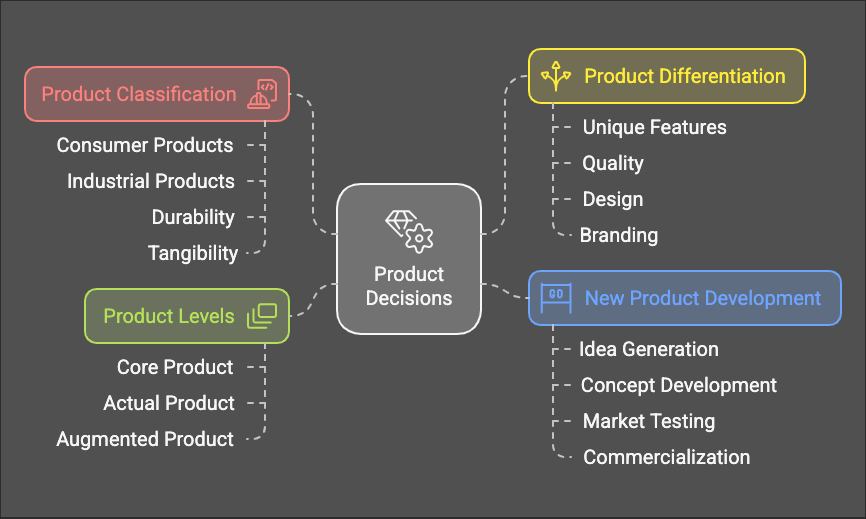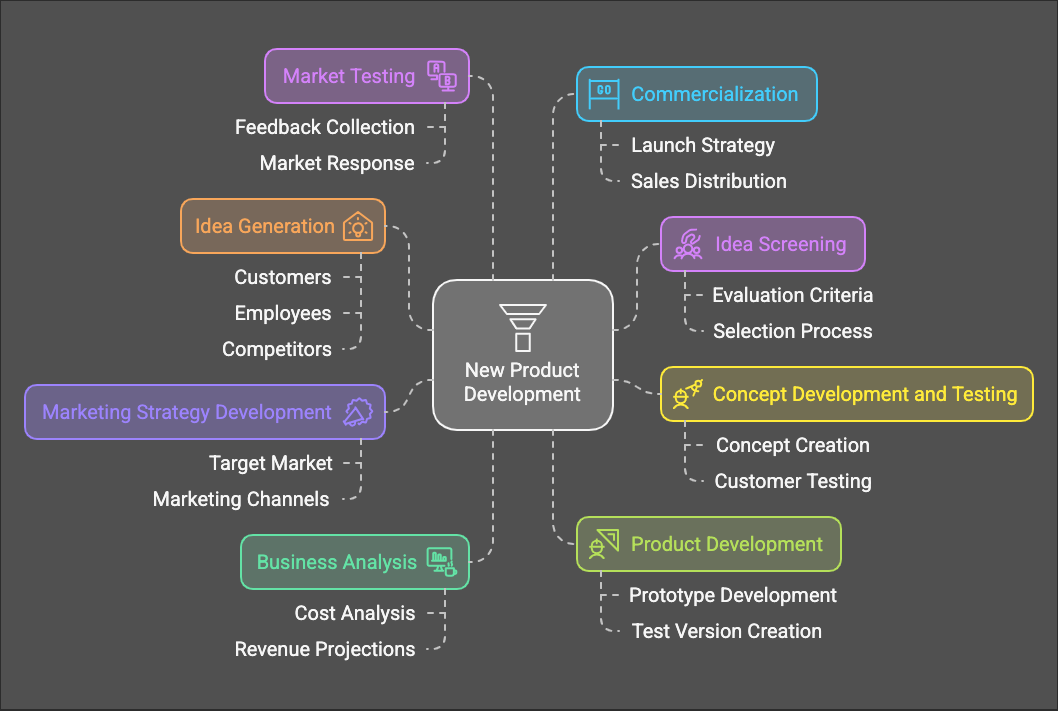Define Setting Product Strategy
Unit III: Product Decisions
This unit explores the exciting world of products and how companies make smart choices to succeed.
Setting Product Strategy
Product Classification
Products can be grouped in different ways to help businesses understand their market and make better decisions. Here are a few common classifications:
- Consumer Products: These are products bought by individuals for personal use. Think about your favorite snacks, clothes, or gadgets.
- Industrial Products: These are products used by businesses to make other products or run their operations. Examples include raw materials, machinery, and office supplies.
- Durability: Products can be durable (long-lasting, like a refrigerator) or non-durable (consumed quickly, like a chocolate bar).
- Tangibility: Products can be tangible (physical goods you can touch) or intangible (services like a haircut or a doctor's visit).
Product Levels
A product is more than just the physical item or service—it has multiple levels that satisfy the customer’s needs. These five levels, introduced by Philip Kotler, are:
1. Core Product
The core product is the fundamental benefit or value that the customer is buying.
- It answers the question: What is the customer really buying?
- It is not a physical product but the basic need or solution the product fulfills.
Examples:
- A smartphone’s core product is communication and connectivity.
- A hotel room’s core product is providing rest and shelter.
2. Basic Product
The basic product refers to the physical or tangible product that provides the core benefit.
- It includes the essential components and features that make the product functional.
Examples:
- For a smartphone: The device itself with its touchscreen, battery, and calling features.
- For a hotel room: The bed, bathroom, and lighting.
3. Expected Product
The expected product encompasses all the attributes or features that customers typically expect when they buy the product.
- These are the minimum requirements that the product must meet to satisfy customer expectations.
Examples:
- A smartphone: Customers expect good battery life, a clear screen, and basic apps like a camera and messaging.
- A hotel room: Customers expect clean sheets, a comfortable mattress, hot water, and basic amenities like soap and towels.
4. Augmented Product
The augmented product includes additional features, services, or benefits that differentiate the product from competitors.
- It goes beyond customer expectations to create added value and improve customer satisfaction.
- This is a key area for product differentiation.
Examples:
- A smartphone: Free cloud storage, extended warranties, customer service, or pre-installed premium apps.
- A hotel room: Free Wi-Fi, complimentary breakfast, swimming pool access, or personalized services like concierge assistance.
5. Potential Product
The potential product represents all future improvements or innovations that could be made to enhance the product and satisfy customers further.
- It is about what the product could become to meet evolving customer needs or take advantage of new technology.
Examples:
- A smartphone: Future updates like foldable screens, enhanced AI assistants, or holographic displays.
- A hotel room: Virtual reality tours, automated room service using robots, or AI-powered guest preferences.
Summary Table for Better Understanding:
| Level | Definition | Example (Smartphone) | Example (Hotel Room) |
|---|---|---|---|
| Core Product | The fundamental benefit or solution the product provides. | Communication and connectivity. | Rest and shelter. |
| Basic Product | The tangible product providing the core benefit. | The phone itself, with basic hardware. | Bed, bathroom, and lighting. |
| Expected Product | The minimum features or attributes expected by customers. | Touchscreen, good battery life, basic apps. | Clean sheets, hot water, soap, towels. |
| Augmented Product | Additional features that add value and differentiate the product. | Free cloud storage, extended warranties. | Free Wi-Fi, complimentary breakfast. |
| Potential Product | Future improvements and innovations. | Foldable screens, holographic displays. | Automated room service, VR experiences. |
Importance of Understanding Product Levels:
- Customer Satisfaction: Recognizing these levels helps companies meet and exceed customer expectations.
- Differentiation: By focusing on the augmented and potential levels, companies can stand out in competitive markets.
- Innovation: Considering the potential product encourages businesses to anticipate customer needs and stay ahead of industry trends.
Product and Services Differentiation
In a crowded market, standing out is key. Companies differentiate their products and services by:
- Unique features: Offering something special that competitors don't have.
- Quality: Building a reputation for superior quality.
- Design: Creating an appealing and functional design.
- Branding: Building a strong brand identity that resonates with customers.
New Product Development
Stages of New Product Development
Bringing a new product to life is a journey with several stages:
- Idea Generation: Coming up with new product ideas from various sources (customers, employees, competitors, etc.).
- Idea Screening: Evaluating ideas and selecting the most promising ones.
- Concept Development and Testing: Creating a detailed concept and testing it with potential customers.
- Marketing Strategy Development: Developing a plan to market the new product.
- Business Analysis: Evaluating the financial viability of the new product.
- Product Development: Creating a prototype or a test version of the product.
- Market Testing: Introducing the product in a limited market to gather feedback.
- Commercialization: Launching the product to the full market.
Categories of New Products
- New-to-the-world products: Completely new inventions that create a whole new market.
- New product lines: Products that allow a company to enter an existing market for the first time.
- Additions to existing product lines: New products that supplement a company's existing product lines.
- Improvements and revisions of existing products: Making existing products better.
- Repositioned products: Existing products targeted at new markets or segments.
- Cost reductions: New products that provide similar performance at a lower price.
Reasons for Launching New Products
- Growth: Increase sales and market share.
- Changing customer needs: Meet evolving customer demands.
- Competition: Respond to competitors' actions.
- Technology: Take advantage of new technologies.
Reasons for New Product Failure
- Poor market research: Not understanding customer needs.
- Lack of differentiation: Failing to stand out from the competition.
- Poor marketing: Not effectively communicating the product's value.
- High costs: Pricing the product too high or having high development costs.
- Technical problems: Product defects or design flaws.


